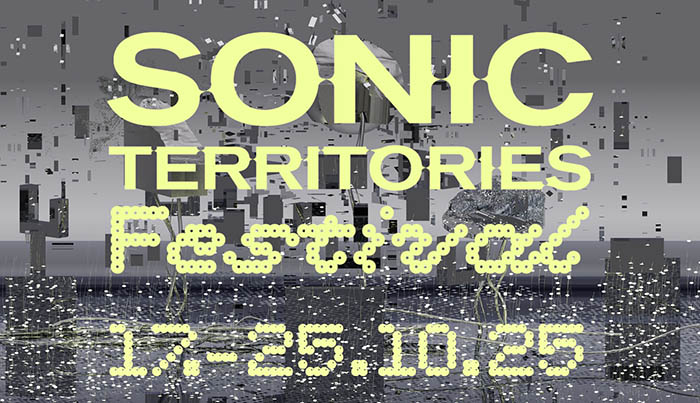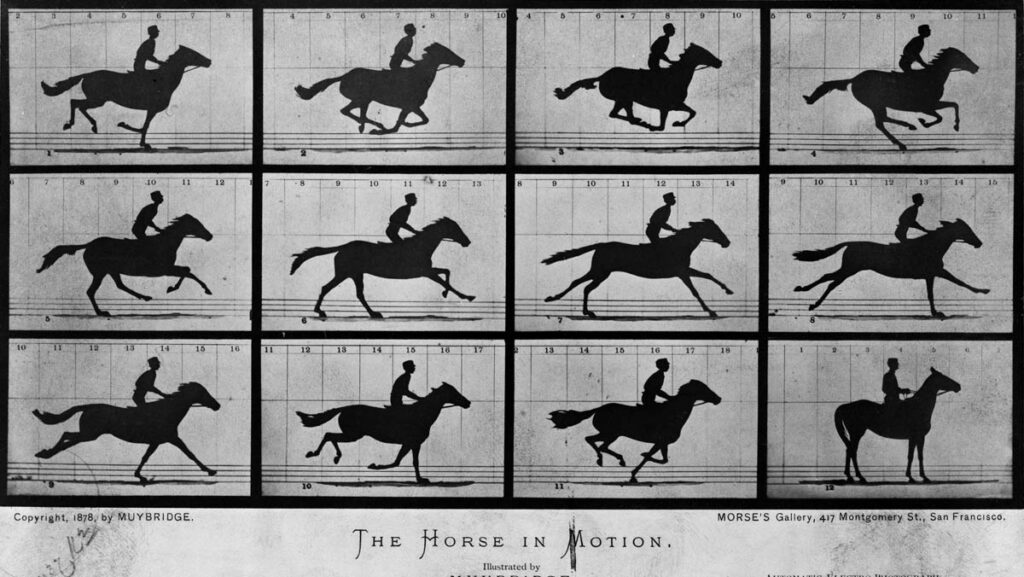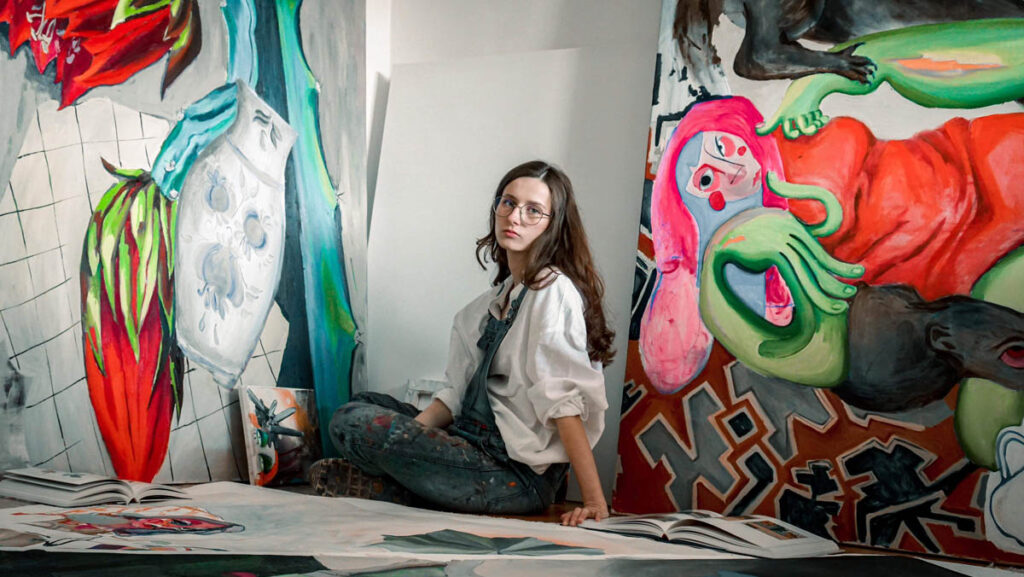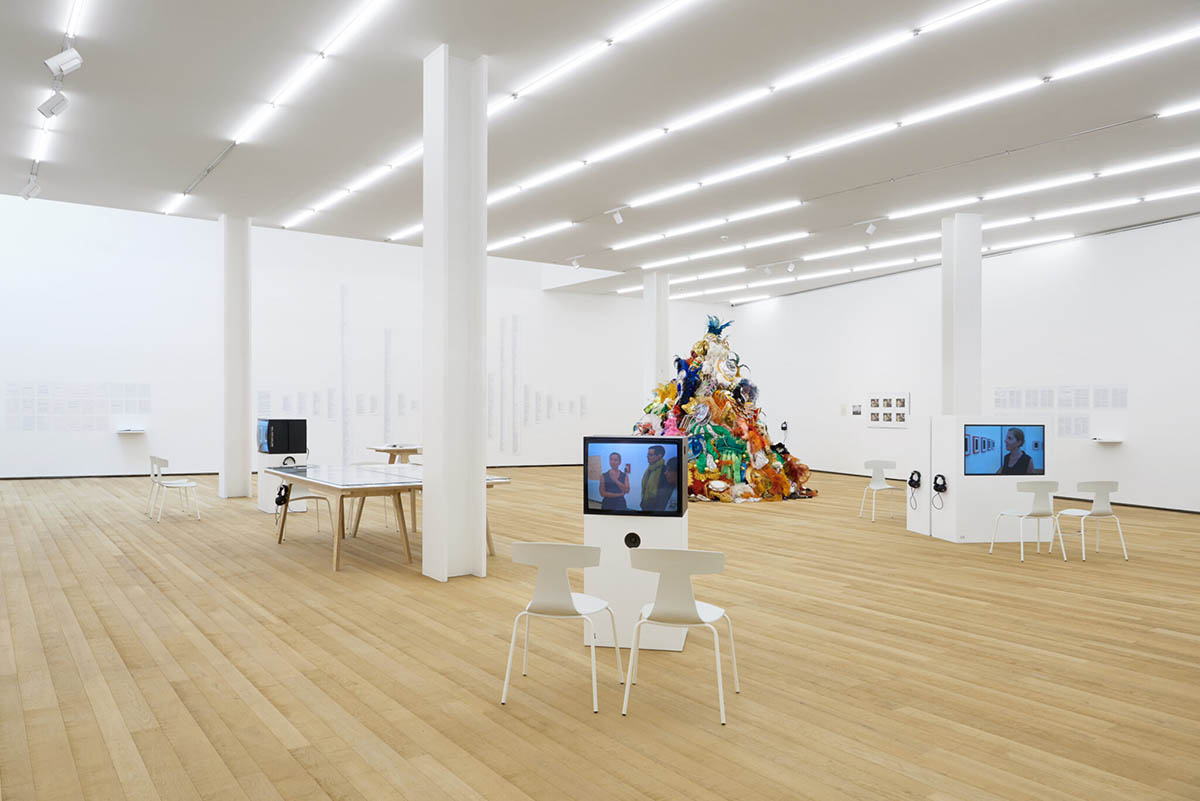
Fraser’s practice is eminently post-aesthetic, heavy on text and speech, and light on visuals. Curated by Andrea Viliani with Vittoria Pavesi, «I just don’t like eggs!», focuses on Fraser’s engagement with collectors, collecting, and collections, offering a welcomed guiding thread into an intricate body of work spanning over thirty years. The exhibition’s centerpiece is the most visual object on display: a mountain of colourful objects that appear both as art and trash and prompt the themes under investigation. Um Monumento às Fantasias Descartadas (2003) [A Monument to Discarded Fantasies] consists of mostly discarded costumes, which Fraser collected during her visit to the carnival of Rio de Janeiro in 2003. Who decides what is valuable and worthy of collection? Who gets to collect and for whom? And based on what criteria? Enveloping Um Monumento, the remainder of the exhibition aims to unearth a social truth by tackling these questions. This is why «I just don’t like eggs!» brims of printed materials: transcribed interviews, correspondence, diagrams, data, and statistics that evince the sexist, racist, and classist mechanisms of the art world.
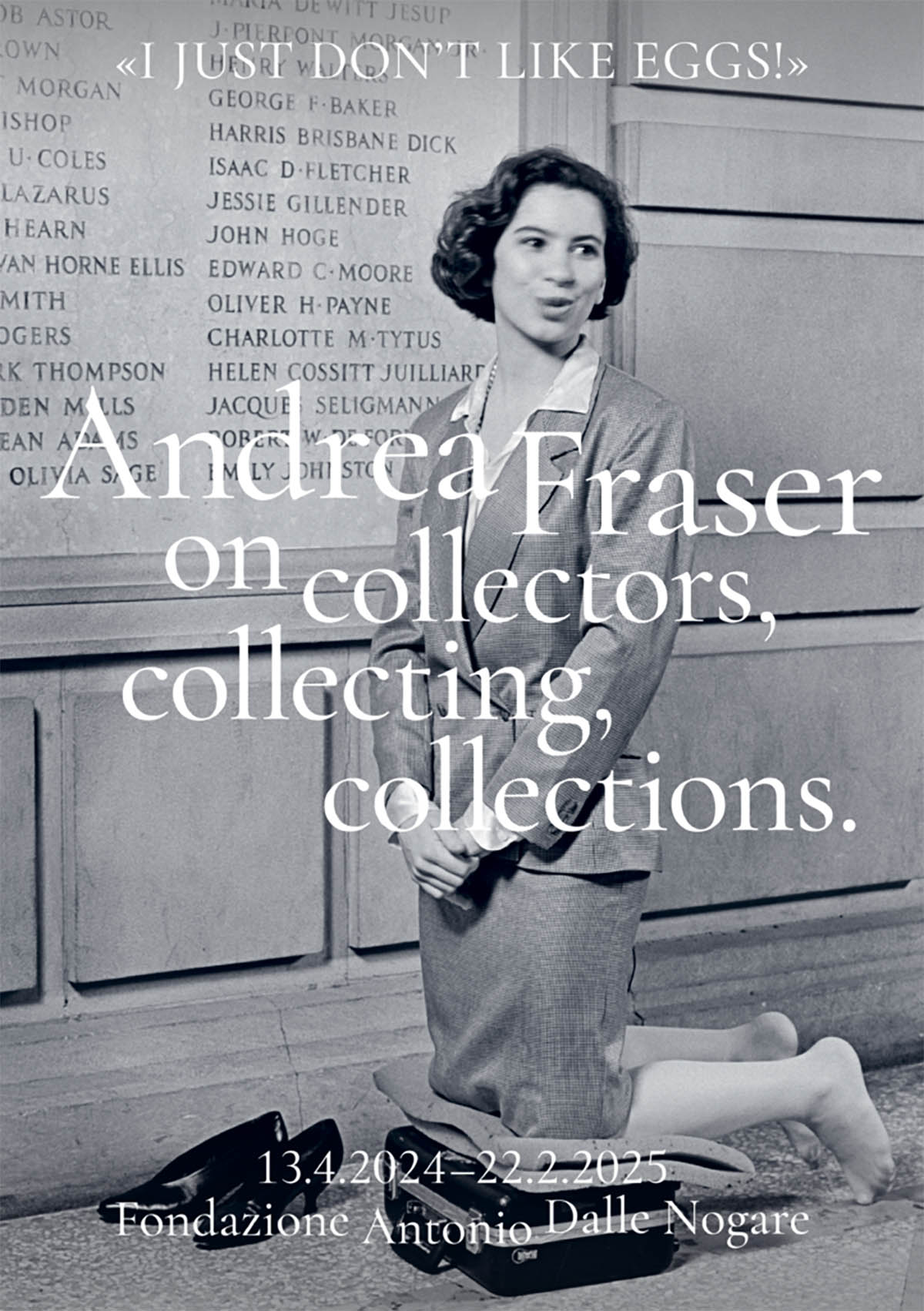
The exhibition comprises around twenty-five artworks from the late 1980s, 1990s, 2000s, and 2010s. The curatorial thread of collecting lessens the density typical of heavily text-based displays. Next to the gallery entrance, the video documentation of the landmark Museum Highlights: A Gallery Talk (1989) exemplifies Fraser’s intricate methods, which span from meticulous research into books, archives, and statistics to absurd performance scripts. A case in point is the protagonist of Museum Highlights: a volunteer tour guide named Jane Castleton (Fraser’s persona) who introduces visitors to the Philadelphia Museum of Art by uttering confident gibberish such as:
… here, the ability to distinguish between a coat room and a rest room, between a painting and a telephone, a guard and a guide; the ability to distinguish between yourself and a drinking fountain, between what is different and what is better and objects that are inside and those that are outside; the ability to distinguish between your rights and your wants, between what is good for you and what is good for society.¹
Drawing on the ‘weight’ of Kantian aesthetics, the artist aptly satirises the classist jargon of the art world, the arbitrariness of artistic value and taste.
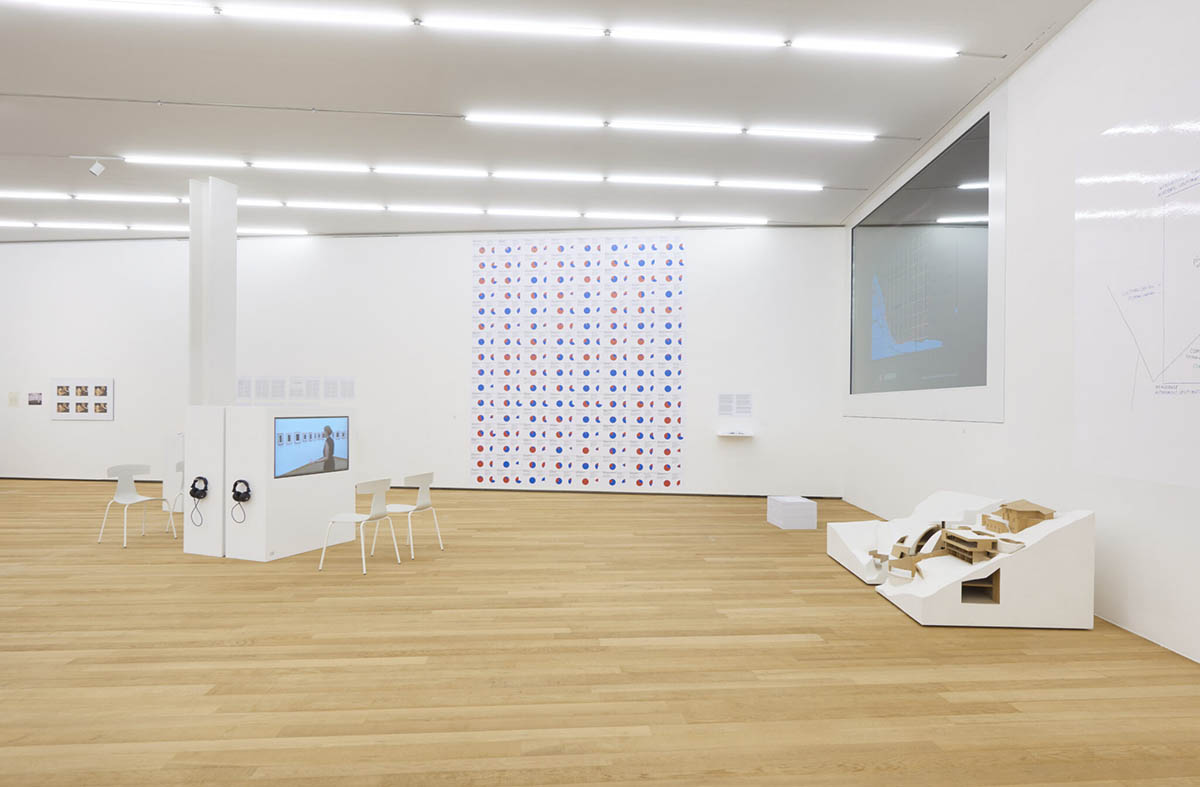
In the main room of the exhibition, photographic, audio, and textual remnants of the performance Untitled (2003–) are arguably the most well-known pieces on display. For Untitled, Fraser asked her gallerist to find a collector who would agree to have sex with her and then purchase one out of the five videos documenting their encounter. Untitled is a landmark piece in art history, described as a feminist intervention in the false idea that art value is beyond the workings of the material world. It shows that art is no stranger to labour and its gendered and class-based inflexions. I spent much time with the partial recreation of Aren’t They Lovely?, a lesser-known installation that hadn’t been viewed since it was first created in 1992 for the University Art Museum at the University of California Berkeley (now the Berkeley Art Museum & Pacific Film Archive). Fraser, who had permission to use any object she wanted from the university’s holdings, decided on a collection donated by alumna Thérèse Bonney. The artist teased out the politics of collecting by displaying not only the 55 artworks and other objects accessioned by the university’s museum, but also approximately 100 more objects that she found in storage and unaccounted for in the inventory. The installation also included a series of wall texts and long object labels, notably the correspondence between Bonney and the university that tells of the hierarchies and power imbalances involved in donations.
Collections aren’t just containers of masterpieces and the complex processes of accessioning and deaccessioning are heavily political: for instance, it may be tricky to refuse the accessioning of a benefactor’s collection even if it does not contribute to the aims and directions of the respective institution. More than that, established institutions rarely practise the consequences of the egalitarian discourses they promote; that is, they rarely act in accord with the fact that a collection is already predicated on the intersection of many exclusions. The politics of collecting became obvious in 2018, amidst the debates sparked by the Baltimore Museum’s decision to deaccession seven artworks, including Andy Warhol’s and Robert Rauschenberg’s, to buy many more by underrepresented artists, especially women and people of colour. Though the partial recreation of Aren’t They Lovely? broaches this fraught topic, what I found lacking in the exhibition overall is a clearer connection between Fraser’s past practice and the state of the art world today, even though the most recent piece on display is still a work in progress. Diagram, made in 2024, is a drawing on a whiteboard that employs the theories of French sociologist Pierre Bourdieu to represent the different spheres where art ‘happens’ and map them, per the interpretation text, ‘within [the] social space structured by distributions of different forms of capital, or power.’ Even with prior knowledge of Bourdieu’s writings, however, the diagram is hard to interpret, possibly because it remains, for now, underdeveloped. The curatorial texts could have better elucidated the lasting significance of the artist’s interventions in a still categorically stratified art world.
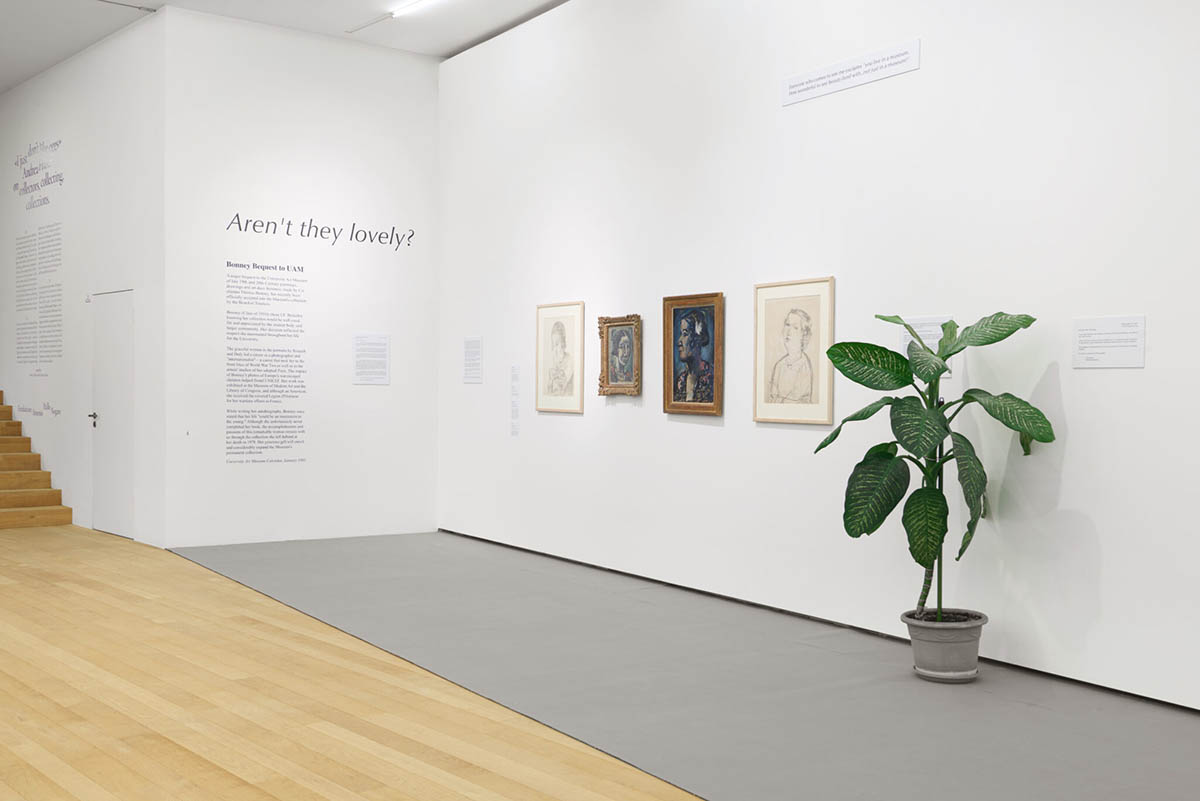
In addition, conspicuously absent is a more overt conversation about the hosting institution. One of the two exhibits that directly engage with the Antonio Dalle Nogare Foundation is an untitled audio installed in the courtyard. The tape was recorded at the California Correctional Institution Tehachapi and was originally played at Schindler House in Los Angeles in 2014. The piece evokes the contradictions between conceptions of freedom and the realities of confinement, as represented by the art institution and the penitentiary system, respectively. Although the interpretative text connects the audio to the Foundation, the generic relation between the two makes for a somewhat anodyne critique: ‘[t]he sound’s further displacement to the eco-brutalist courtyard of the Antonio Dalle Nogare Foundation presents a new set of parallels and contradictions: between openness and fortress-like security, […] between asceticism as a luxury aesthetic and asceticism as deprivation and punishment.’ Fairly tame is also a maquette of the hosting foundation, which was not made by Fraser but was included in the exhibition ‘with the artist’s and curators’ endorsement’. As the interpretative text explains, the maquette ‘does not provide answers, but merely poses a question, as does this text, if only by mentioning that the funds for the realization of this exhibition come mainly from the real estate construction business of the institution’s founder – who is also a collector of contemporary art and whose private residence is located directly above the Foundation.’
But this is a conundrum as old as the art practices critical of the institutions they host them.
On 25 September 2024, Fraser will perform May I Help You? for the first time in Italy, re-activated in the collection of the Fondazione Antonio Dalle Nogare.
Exhibition: I just don’t like eggs! Andrea Fraser on collectors, collecting, collections
Curated by Andrea Viliani with Vittoria Pavesi
Exhibition duration: 13.04.2024 — 22.02.2025
Address and contact:
Antonio Dalle Nogare Foundation
Rafensteiner Weg, 19, 39100 Bolzano, Italy
www.fondazioneantoniodallenogare.com
¹ Andrea Fraser, ‘Museum Highlights: A Gallery Talk’, October (Summer 1991), pp. 104-122, p. 122.



